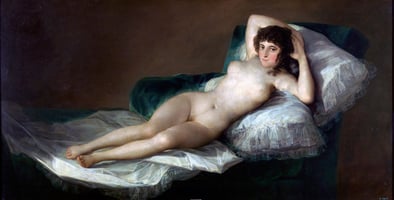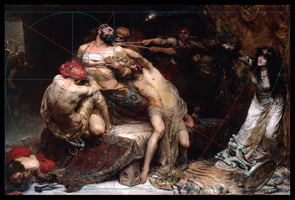The Black Paintings of Francisco Goya are not only some of the most important and influential...
Sight size painting
1. What is Sight Size Painting?
Sight size painting is a technique that can be used by artists to achieve accurate proportions in their paintings. The idea is to set up a viewfinder or canvas at a specific distance from the subject, and then paint what is seen within the viewfinder. This helps to ensure that the painting will be in correct proportion to the subject.
Sight size painting was popularized by the 19th century French artist Charles-Francois Daubigny, who used it to paint landscapes. It is still used today by many artists, including portrait painters, who find it to be an effective way to achieve accurate likenesses.
There are two main benefits to sight size painting. The first is that it allows the artist to get an accurate representation of the subject matter. The second is that it allows the artist to work on the painting over a period of time, making adjustments as needed.
The main disadvantage of sight size painting is that it can be time-consuming. The artist needs to be very precise in their measurements, and they need to be able to work slowly and carefully. However, the results can be well worth the effort!
If you're thinking of trying sight size painting, here are a few tips to help you get started:
1. Choose a subject that is not moving. This will make it easier to get an accurate representation.
2. Set up your viewfinder or canvas at the correct distance from the subject. This distance will vary depending on the size of the subject.
3. Take your time. Sight size painting can be a slow process, but it's important to be patient and work carefully.
4. Make adjustments as needed. If you find that your painting is not in proportion, make adjustments to the distance of the viewfinder or canvas.
With a little practice, you'll be able to create paintings that are accurate and beautiful!
2. The Benefits of Sight Size Painting
Sight size painting is a technique where the artist matches the size of their subject with the size of their canvas. This results in a more realistic painting.
There are many benefits to sight size painting. One benefit is that it allows the artist to get a better sense of scale and proportion. This is because the artist can compare the size of their subject directly with the size of their canvas. As a result, the artist can make more accurate adjustments to the size of their subject.
Another benefit of sight size painting is that it can help the artist to achieve a greater sense of depth and perspective. This is because the artist can place their subject further back or closer to the front of the canvas, depending on the desired effect.
Lastly, sight size painting can help the artist to create a more realistic painting overall. This is because the artist is able to paint what they see, rather than what they imagine.
Sight size painting is a great way to achieve a more realistic painting. If you're looking for a way to improve your paintings, give sight size painting a try!
3. The History of Sight Size Painting
Sight size is a traditional method of painting that dates back to the Renaissance. This method involves matching the size of the subject with the size of the painting. Sight size was used by some of the great masters of the Renaissance, such as Leonardo da Vinci, Michelangelo, and Raphael.
Today, sight size is enjoying a resurgence in popularity due to the work of contemporary realist painters such as John Singer Sargent and Richard Diebenkorn. There are several benefits to using the sight size method, including the ability to achieve a high level of detail and realism.
Despite its benefits, sight size does have some drawbacks. For example, it can be time-consuming to set up the easel and view the subject at the correct distance. Additionally, it can be difficult to maintain the correct distance from the subject, especially if the subject is moving.
Despite its drawbacks, sight size remains a popular method for creating realistic and detailed artworks.
4. The Different Types of Sight Size Painting
Sight size painting is a painting technique used to produce realistic paintings. The artist uses a measuring device, usually a ruler, to determine the size of the subject. They then paint the subject to that scale. This type of painting can be used for portraiture, still lifes, or landscapes.
There are two main types of sight size painting: comparative and exact. In comparative sight size painting, the artist compares the subject to a reference object, such as a ruler or another painting. The artist then adjusts the size of the subject accordingly. In exact sight size painting, the artist matches the size of the subject exactly to the measuring device.
Comparative sight size painting is generally considered to be more accurate than exact sight size painting, as it takes into account the actual size of the subject rather than just the measurement. However, exact sight size painting can be more precise, as it allows the artist to control the size of the painting more precisely.
Sight size painting is a versatile technique that can be used to produce realistic paintings of any subject. Whether you want to paint a portrait, a still life, or a landscape, sight size painting can help you achieve your goal.
There are also variations of sight size painting, such as multi-point and continuous sight size. Multi-point sight size is when the artist paints a subject while moving their eye between multiple fixed points in space. Continuous sight size is when the artist paints a subject while keeping their eye in a continuous fixed position in space.
No matter what type of sight size painting you choose to do, the results can be truly amazing. If you're looking to create realistic paintings, this is definitely a technique you should consider.
5. How to Sight Size Paint
When it comes to painting, the Sight Size method is a great way to achieve accurate results. Here's a quick guide on how to Sight Size paint:
1. Find a subject that is the same size as your canvas.
2. Set up your easel so that the subject and the canvas are at the same eye level.
3. Measure the distance between the subject and the canvas, and mark that same distance on the ground.
4. To begin, paint a small section of the subject, and then step back to see how it looks.
5. If it looks good, then you can continue painting. If it doesn't look good, then you need to adjust your easel accordingly.
6. Keep repeating this process until the painting is complete.
Keep the following things in mind and you'll be able to master the Sight Size method in no time:
1. Make sure you have a good understanding of the proportions of the subject you're painting.
2. Find the right vantage point from which to paint the subject.
3. Use the Sight Size method to achieve the desired results.
Sight Size painting is a great way to get accurate results. Keep the above tips in mind and you'll be painting like a pro in no time!
6. Sight Size Painting Tips and Tricks
If you're an artist who wants to create realistic and visually appealing paintings, the sight size painting technique may be for you. With this technique, artists view the subject matter from a specific distance and then paint it to match that size. This way, the finished painting is accurate in terms of perspective and scale.
There are a few things you need to keep in mind when using sight size to paint:
-You should set up your easel at the same distance from the subject matter as you intend to view it when the painting is complete. This will help you to gauge the correct proportions.
-It is essential to use a plumb line to align the top and bottom edges of the painting. This creates a sense of depth and perspective in the painting.
-When painting the subject matter, take care to make it look true to life. This means using accurate colors and values.
By following these tips, you can produce paintings that look realistic and professional.
If you're new to sight size painting, or if you're having trouble getting the proportions just right, don't worry! Here are a few extra tips and tricks to help you master the technique:
-Practice with simple shapes first, such as cubes or spheres. This will help you get a feel for sizing up objects directly.
-Once you feel comfortable with basic shapes, try painting a still life. Start with small objects, and then work your way up to larger ones.
-If you're having trouble getting the proportions just right, try using a grid. Draw a grid on your canvas, and then use it to help you map out the proportions of your subject matter.
-Finally, don't be afraid to ask for help! If you're struggling with this technique, seek out a tutor or a friend who is a more experienced painter. They can offer guidance and support.
7. The Best Sight Size Painting Supplies
When it comes to painting, there is no one-size-fits-all answer. Each artist has their own individual preferences and style. However, when it comes to sight size painting, there are some common supplies that are often used.
Sight size painting is a method of painting in which the artist lines up their view of the subject with the canvas, using a sight-size rectangle. The artist then adjusts the size of their brushstrokes to match the size of the rectangle. This results in very realistic and proportionate paintings.
Some of the best sight size painting supplies include a T-square, a ruler, and a tape measure. These supplies will help the artist to keep their view of the subject aligned with the canvas, and to accurately measure the size of their brushstrokes.
If you're interested in trying out sight size painting, make sure to invest in high quality supplies. This will ensure that you get the best results possible. There are many different brands and types of supplies available on the market, so it is important to do your research in order to find the best ones for your needs. You can ask other artists for recommendations, or look for reviews online. Once you find the supplies that work best for you, stick with them to ensure consistent results.
If you're an artist who wants to create realistic and proportional paintings, then the sight size painting technique is something you should definitely consider.
This technique involves matching the size of your subject with the size of your canvas. This results in a painting that looks just like the real thing, in terms of size and proportion.
However, there are a few things to keep in mind when using this technique. For example, you need to use a horizon line to establish correct proportions. Additionally, you need to use a plumb line to ensure that vertical lines are accurate.
It's also important to take accurate measurements and to use a reference photo if one is available. And finally, remember that sight size painting is all about accuracy. This means that you need to be patient and take your time.
If you keep these things in mind, then you'll be well on your way to creating amazing sight size paintings that look just like the real thing.
8. Sight Size Painting Mistakes to Avoid
Sight size painting is a technique used by artists to achieve realistic proportions in their paintings. The term "sight size" refers to the fact that the artist views the subject at the same distance as the painting surface. This allows the artist to accurately gauge the size of the subject and translate it onto the painting surface.
There are many benefits to using sight size painting, including the ability to achieve realistic proportions, create the illusion of depth, and create a sense of unity between the painting and the viewer. Additionally, sight size painting can be used to create paintings that are both aesthetically pleasing and technically precise.
Despite the many benefits of sight size painting, it is not without its challenges. One of the biggest challenges is that it can be time-consuming, as the artist must take care to view the subject at the same distance as the painting surface. Additionally, it can be difficult to achieve the correct perspective when using sight size painting, as the artist must be careful to maintain the correct relationship between the subject and the painting surface.
Despite the challenges, sight size painting is a technique that can produce stunning results. If you are looking for inspiration, there are many great examples of sight size painting online and in art history books.
9. Sight Size Painting Inspiration
Sight size painting is a method of painting in which the artist sets up the canvas so that the subject is the same size as it appears to the artist. This allows the artist to achieve a realistic representation of the subject.
There are many benefits to sight size painting, including the ability to achieve accurate proportions and perspective, and the opportunity to study the subject in great detail. This method of painting can be used for any subject matter, but is particularly well suited for portraiture and still life painting.
If you are new to sight size painting, or are looking for some inspiration, here are a few examples of artists who use this method:
1. John Singer Sargent: Sargent was a renowned portrait painter who used sight size painting to achieve his realistic style.
2. Andrew Wyeth: Wyeth was a 20th-century American painter who often used sight size painting in his rural landscapes.
3. Chuck Close: Close is a contemporary American artist known for his large-scale portraits. He often uses a grid system when painting, but adjusts the canvas size to match the subject's actual size.
4. Lucian Freud: Freud was a British painter who used sight size painting to capture the intimate details of his subjects.
5. Julie Curtiss: Curtiss is a contemporary artist who uses sight size painting in her figurative works.
As the world of art evolves, new genres and styles are constantly emerging. While some artists embrace these changes, others remain loyal to traditional methods. This is especially true for those who practice sight size painting.
10. The Future of Sight Size Painting
Sight size painting is a method of painting that allows the artist to achieve accurate proportions in their work. This approach is often used by portrait painters, as it helps to ensure that the subject is depicted with realistic proportions.
Despite its popularity, the future of sight size painting is uncertain. The rise of new genres and styles has led many artists to explore different approaches. This has caused some to question whether sight size painting is still relevant.
However, there are still those who believe in the power of this traditional method. Sight size painting is considered to be one of the best ways to achieve accurate proportions in a painting. For this reason, many artists continue to practice this approach.
The future of sight size painting will likely depend on the continued interest of artists in this traditional method. If more artists begin to explore new genres and styles, the sight size method may become less popular. However, if artists continue to value the precision and control that sight size painting offers, the future of this approach looks bright.




